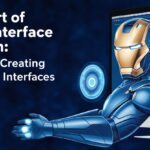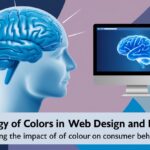Typography is an essential component of web design. It is the art of arranging type to make written language legible, readable, and appealing when displayed. Typography trends in modern web design have evolved over the years, from the use of serif and sans-serif fonts to the use of bold and creative typography.
Modern web design typography trends have changed drastically over the past decade. The use of bold and eye-catching fonts has become more popular, as designers seek to create a unique and memorable user experience. The use of typography in web design can influence the user’s perception of the website, and can even affect their decision to stay or leave. Therefore, it is important for designers to stay up-to-date with the latest typography trends in web design to create visually appealing and effective websites.
In this article, we will explore the latest typography trends in modern web design. We will examine how typography can be used to create a unique and memorable user experience, and how it can influence the user’s perception of the website. Additionally, we will discuss the importance of staying up-to-date with the latest typography trends in web design to create visually appealing and effective websites.
Understanding Typography
Typography is the art of arranging text to make it readable and appealing when displayed. The typography used in modern web design is a critical aspect of the overall design and user experience. It involves the selection of appropriate fonts, font pairing, font size, and other factors that can affect the readability of the text.
The choice of font typeface is one of the most important decisions when it comes to typography. Serif fonts are traditional fonts with small lines or flourishes at the end of each character, while sans-serif fonts are more modern and do not have these lines. Sans-serif fonts are often used for digital text, as they are more legible on screens.
Font pairing is the art of selecting two or more fonts that complement each other and create a visually appealing design. This can be achieved by pairing a serif font with a sans-serif font, or by combining different styles of the same font family.
Font size is another critical factor in typography. The size of the font should be appropriate for the content and the device on which it is being viewed. For example, a large font size may be suitable for a headline, while a smaller font size may be more appropriate for body text.
Italic, bold, all caps, and monospace are other font styles that can be used to create emphasis or to differentiate between different types of content. Display fonts, variable fonts, and flexible fonts are also becoming increasingly popular in modern web design, as they offer greater flexibility and creativity.
Retro fonts, script fonts, bold typefaces, and 3D type are some of the typography trends that are currently popular in modern web design. Minimalist fonts and fat fonts are also gaining popularity due to their simplicity and boldness.
In conclusion, understanding typography is critical to creating effective and visually appealing modern web designs. The selection of appropriate fonts, font pairing, font size, and other factors can significantly impact the readability and overall user experience.
Typography in Web Design
Typography is an essential element of web design that can make or break the user experience. It involves the selection of fonts, their size, spacing, and colour, among other things. Typography is a powerful tool that can help designers create hierarchy, contrast, and legibility on a website.
The choice of typography in web design should be based on the website’s brand identity, layout, and purpose. The typography should be consistent with the website’s branding and help to convey the intended message. The designer should also consider the website’s layout and hierarchy when choosing typography.
Contrast is another important aspect of typography in web design. The contrast between the background and the text should be sufficient to ensure legibility. The designer should also consider the contrast between different elements of the website, such as headings and body text.
Colour can also play a role in typography in web design. The designer should consider the colour contrast between the text and the background to ensure legibility. The designer can also use colour to create contrast between different elements of the website, such as headings and body text.
Images and logos are often an integral part of a website’s design. The designer should consider typography that complements the images and logos and helps to convey the intended message.
Web typography has evolved significantly in recent years, with designers using a wide range of fonts and font combinations to create unique and engaging designs. Webflow is a popular tool for designing websites that allows designers to create custom typography.
UI design and website speed are also important considerations when it comes to typography in web design. The designer should consider the impact of typography on website speed and ensure that the typography is optimised for performance.
In summary, typography is an essential element of web design that can make a significant impact on the user experience. The designer should consider the website’s brand identity, layout, hierarchy, contrast, colour, images, logo, branding, and web typography when choosing typography for a website.
Impact of Typography on User Experience
Typography plays a crucial role in modern web design. It can make or break the user experience of a website. A well-chosen font can make the content more readable and legible, while a poor font choice can make it difficult to read and unappealing.
The readability of the text is one of the most important factors when it comes to user experience. A readable font is easy to read, and the user can quickly understand the content. On the other hand, an unreadable font can cause eye strain and make it difficult for the user to focus on the content.
Line length, line height, and line spacing are other factors that can impact the readability of the text. A long line length can make it difficult for the user to read the text, while a short line length can make the text look cramped. Similarly, a small line height and line spacing can make the text difficult to read, while a large line height and line spacing can make the text look too spread out.
Kerning, alignment, placement, and whitespace are other aspects of typography that can impact the user experience. Kerning refers to the space between letters, and good kerning can make the text more legible. Alignment and placement can make the text look more organized and easy to read, while whitespace can help to break up the content and make it more visually appealing.
In summary, typography is a critical aspect of modern web design that can have a significant impact on the user experience. Choosing the right font, line length, line height, line spacing, kerning, alignment, placement, and whitespace can make the text more readable, legible, accessible, and appealing to the user.
Typography and Visual Aesthetics
Typography plays a significant role in modern web design. It is not only about selecting a font that is easy to read, but it is also about creating a visual hierarchy that enhances the overall user experience. Designers use typography to evoke emotions, convey personality and image, and create a unique brand identity.
Serifs and sans-serif fonts are two popular categories of fonts used in web design. Serif fonts are known to convey a classic, elegant, and traditional feel, while sans-serif fonts are often used for a modern, clean, and minimalist look.
In terms of case, uppercase letters are often used for headings and subheadings to make them stand out and create a visual hierarchy. Lowercase letters, on the other hand, are easier to read for body text.
Headers are often used to introduce a section or a page, and they should be clear, concise, and attention-grabbing. Subheadings, on the other hand, provide more information and context to the reader.
Animated typography and kinetic typography are two trends that have gained popularity in recent years. Animated typography involves adding motion to text to create a dynamic and engaging user experience. Kinetic typography, on the other hand, involves animating text to match the rhythm and pace of an audio track.
Gradients are another design element that can be used to enhance the visual aesthetics of typography. Gradients can add depth and dimension to text, making it more visually appealing.
In conclusion, typography and visual aesthetics are closely intertwined in modern web design. Designers use typography to convey personality, create a unique brand identity, and enhance the overall user experience. By selecting the right fonts, using appropriate case, and incorporating design elements such as gradients, designers can create visually appealing and engaging typography.
Typography Trends in Modern Web Design
Typography is an essential element of web design that can make or break the user experience. The right choice of fonts, font sizes, and colours can grab the user’s attention and enhance the readability of the content. In modern web design, typography has evolved to become more than just a means of communication. It is now a tool for creating visual interest, establishing brand identity, and conveying emotions.
One of the current trends in typography is the use of bold colours. Bold colours can add vibrancy to the design and help draw attention to specific elements, such as headlines or calls to action. However, designers need to use bold colours judiciously to avoid overwhelming the user.
Another trend in typography is the use of subtle and elegant fonts. These fonts are often used in conjunction with bold colours to create a balanced and harmonious design. Monospaced fonts are also gaining popularity in modern web design. These fonts have a fixed width, making them ideal for creating a clean and structured layout.
Geometric sans serif fonts are another popular trend in typography. These fonts have a modern and minimalist look and are often used for headings and subheadings. They are also suitable for creating a mid-century modern look and feel.
In conclusion, typography is an essential element of modern web design. Designers need to stay up to date with the latest typography trends to create visually appealing and user-friendly designs. By using bold colours, subtle fonts, monospaced fonts, and geometric sans serif fonts, designers can create designs that are both aesthetically pleasing and functional.
Typography and Brand Identity
Typography plays a crucial role in creating a brand identity. A brand is more than just a logo; it is the overall perception that a customer has of a business. Typography can help create a consistent visual language that reinforces the brand’s message and values.
A well-designed brand identity system includes a logo, wordmark, or logotype that is easily recognizable and memorable. The typography used in these elements should be carefully chosen to reflect the brand’s personality and values. For example, a luxury brand might use a serif font to convey elegance and sophistication, while a tech startup might use a sans-serif font to convey modernity and innovation.
Consistency is key when it comes to typography and brand identity. All typography used in a brand’s communication should be consistent in terms of font, size, and colour. This helps to create a cohesive and recognisable visual language that reinforces the brand’s message.
In addition to the logo and wordmark, typography is also important in other aspects of a brand’s communication, such as advertising, packaging, and website design. Consistent typography across all these touchpoints helps to create a strong and memorable brand identity that customers can easily recognise and remember.
Overall, typography is a powerful tool in creating a brand identity that resonates with customers. By carefully choosing fonts and using them consistently across all touchpoints, businesses can create a visual language that reinforces their message and values, and helps to build a strong and recognisable brand identity.
Typography and Marketing
Typography plays a crucial role in the success of modern web design, especially when it comes to marketing. Choosing the right font, size, spacing, and colour can make a significant impact on the target audience and their perception of the brand.
Marketing channels such as social media, email, and websites rely heavily on typography to convey information effectively. For example, email marketing campaigns that use a clear and easy-to-read font are more likely to be read and have a higher click-through rate. Similarly, social media posts with bold and attention-grabbing typography are more likely to be shared and engage the audience.
The target audience is also an essential consideration when it comes to typography in marketing. Different age groups, demographics, and cultures have different preferences for font styles and sizes. Therefore, it is crucial to choose typography that resonates with the target audience and aligns with the brand’s message.
In addition to the font style and size, the information conveyed through typography is equally important. The typography should be used to highlight key information, such as product features, benefits, and pricing. The use of bullet points, bold, and italic can help break up the information and make it easier to read and understand.
Overall, typography is an essential element of modern web design, and it plays a critical role in marketing. By choosing the right typography, businesses can effectively convey their message to the target audience and achieve their marketing goals.
Typography and Accessibility
In modern web design, typography plays a crucial role in creating an accessible website. Accessibility is the ability of a website to be used by people with disabilities, such as visual impairments, dyslexia, and colour blindness. Thus, it is essential to use legible fonts that are easy to read for people with visual impairments.
One of the most significant trends in typography is the use of bold fonts. Bold fonts make the text more visible and legible, especially on smaller screens. It is also important to use fonts that are accessible to people with dyslexia. Dyslexia is a learning disorder that affects a person’s ability to read, write, and spell. Using a legible font can help people with dyslexia to read the text easily.
In addition to using legible fonts, it is important to consider the contrast between the text and the background. A high contrast between the text and the background can make it easier for people with visual impairments to read the text. It is also important to avoid decorative fonts as they can make the text difficult to read.
Finally, it is important to consider the font size. A larger font size can make the text more accessible to people with visual impairments. It is also important to provide the option to increase the font size for users who need it.
Overall, using legible fonts, high contrast, and larger font sizes can make the website more accessible to people with disabilities. By designing with accessibility in mind, designers can create websites that are accessible to everyone.
Typography and Tech Websites
In recent years, typography has become an essential element of web design, and tech websites are no exception. The use of typography in tech websites is not only about aesthetics but also about functionality. The typography used in tech websites must be readable, legible and convey the right message to the users.
Tech websites usually have a lot of content, and typography plays a crucial role in making the content readable and engaging. The right font size, spacing, and line-height can make a big difference in how users perceive the content. Tech websites often use sans-serif fonts, which are clean, modern, and easy to read.
Moreover, tech websites often use bold typography to highlight important information or make a statement. Bold typography can help to create hierarchy and guide the user’s attention to the most important parts of the website.
Another trend in typography for tech websites is the use of custom fonts. Custom fonts can help to create a unique brand identity and make the website stand out from the competition. However, it is important to ensure that custom fonts are readable and legible, even on smaller screens.
In conclusion, typography is an essential element of web design, and tech websites are no exception. Tech websites need to use typography that is not only aesthetically pleasing but also functional and readable. The use of sans-serif fonts, bold typography, and custom fonts are some of the trends that are popular in typography for tech websites.
Typography and Packaging Design
Typography plays a crucial role in packaging design. It is the visual component that communicates the brand message and creates a lasting impression on the consumer. The right typography can make a brand stand out from its competitors and convey a sense of quality and professionalism.
One of the latest trends in packaging design is the use of bold and impactful typography. Brands are using typography to create a strong visual identity, with bold fonts that catch the eye and convey a sense of confidence. Sans-serif fonts are particularly popular, as they provide a clean and modern look that is easy to read.
Another trend in packaging design is the use of custom typography. Brands are creating bespoke fonts that are unique to their brand, giving them a distinct visual identity. This is particularly effective for luxury brands, where the typography can convey a sense of exclusivity and quality.
In modern web design, typography is also playing a key role. The rise of responsive design means that typography needs to be adaptable to different screen sizes and devices. Brands are using larger fonts and bolder typography to make their message stand out on smaller screens.
In addition, web designers are experimenting with typography to create unique and memorable user experiences. This includes using typography as a design element, rather than just a means of conveying information. For example, typography can be used to create interesting shapes and patterns, or to create a sense of movement and depth.
Overall, typography is a critical component of both packaging design and modern web design. By using bold and impactful typography, brands can create a strong visual identity that sets them apart from their competitors. As the world becomes increasingly digital, typography is only going to become more important in the years to come.







